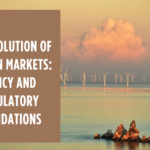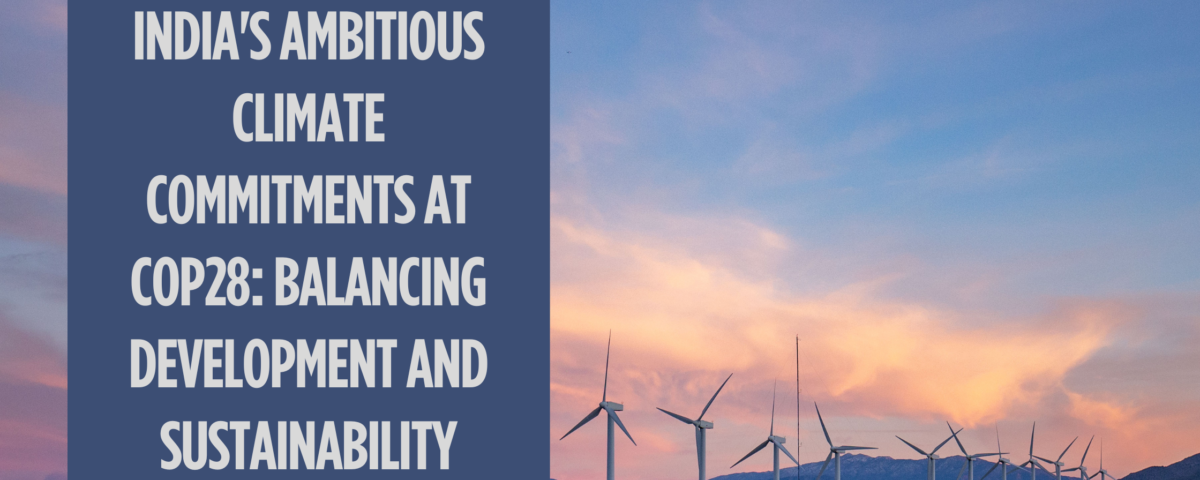
Strategies for implementing low-cost finance for energy transition in India
June 12, 2023
Evolution of Carbon Markets: Policy and Regulatory Foundations
November 14, 2024The 28th annual United Nations Climate Change Conference of the Parties (COP28) is currently underway in Dubai, United Arab Emirates, from November 30 to December 12, 2023. The conference, which follows a year of extreme weather events and broken climate records, is a crucial platform for global leaders to discuss and negotiate strategies to limit and prepare for future climate change.
India’s Role at COP Conferences
India has played a significant role in COP conferences. Indian has made substantial announcements that reflect its balancing act between developmental needs and environmental sustainability.
India has been actively participating in COP conferences since the 1992 Rio de Janeiro Earth Summit, which gave rise to the UN Framework Convention on Climate Change (UNFCCC). Over the years, India has consistently emphasised the principle of Common but Differentiated Responsibilities and Respective Capabilities (CBDR-RC) to address the unequal burdens of climate change on different countries. India’s main effort at the COPs has been to prevent the erosion of this principle and advocate for climate equity.
India’s Climate Pledge: The “Panchamrit” Promise
At the heart of India’s climate strategy is the ambitious “Panchamrit” pledge, introduced at COP26 in 2021. This five-part pledge outlines India’s roadmap towards a sustainable future:
- 500 GW of Non-Fossil Electricity Capacity: This ambitious target puts India at the forefront of renewable energy adoption. However, reaching this goal will require significant scaling up of infrastructure and investment. India’s success in rapidly expanding its solar and wind energy capacities in recent years sets a positive precedent, but the pace needs to be accelerated to meet this target.
- Half Energy from Renewables: Shifting half of its energy requirements to renewables is a bold move for a country heavily reliant on coal. This transition will not only reduce carbon emissions but also improve air quality and public health. The key challenge lies in managing the intermittency of renewable sources and ensuring grid stability.
- Reducing Emissions by 1 Billion Metric Tonnes: This target is particularly significant given India’s growing energy needs. Achieving this will require not just an expansion of renewable energy but also enhancements in energy efficiency across industries and buildings.
- Lowering Emissions Intensity of GDP: Reducing the emissions intensity of its GDP involves decoupling economic growth from carbon emissions. This is a crucial step towards a sustainable development model but requires technological innovation and efficiency improvements across all sectors of the economy.
- Net-Zero by 2070: Setting a net-zero target for 2070 indicates India’s long-term commitment to climate action. This target is more aligned with India’s development needs and capabilities compared to more aggressive timelines set by some developed countries.
Developments at COP28
Prime Minister Shri Narendra Modi reiterated India’s COP-26 commitments, including a 45% reduction in emissions intensity of GDP and a 50% share of non-fossil fuels by 2030, with a net-zero target by 2070.
Further, Prime Minister Shri Modi has proposed the New Collective Quantified Goal (NCQG) and endorsed the Loss and Damage Fund, underscoring India’s commitment to shaping a fair and equitable global response to climate change. India has been instrumental in advocating for a “phasedown” of fossil fuels and pushing for developed nations to commit to being “carbon negative” by 2050.
In addition, India doubled down on its right to increase climate emissions, emphasising the need for a balanced approach that considers the country’s economic expansion and growing energy demands.
Loss and Damage Fund
The Loss and Damage Fund was established in principle during COP27 in Egypt and was officially launched during the opening day of COP28 in Dubai. The initial funding is estimated to be $300 million, with contributions from various countries, including the United Arab Emirates, Germany, the UK, the US, and Japan.
India strongly supports the decision to operationalize the Loss and Damage Fund. It has focused on clarifying the handling of the Loss and Damage Fund, which aims to compensate low-income countries bearing the brunt of climate change.
However, India has so far declined to make financial contributions to this fund, arguing its high emissions are recent and pointing to the “historical responsibility” of developed nations to pay for climate damage.
Green Credit Initiative
India has introduced the Green Credit Initiative, a market-based mechanism designed to incentivize voluntary environmental actions across various sectors by diverse stakeholders, such as individuals, communities, private-sector industries, and companies. The initiative focuses on creating carbon sinks through people’s participation and aims to surpass the commercial nature of carbon credits.
The Green Credit Initiative was launched by the Indian Ministry of Environment in October and was officially launched during the opening day of COP28 in Dubai. The initiative envisions the issue of green credits for plantations on waste/degraded lands and river catchment areas to rejuvenate and revive natural ecosystems. The web platform for the initiative was launched at COP28, inviting other countries to join and collaborate in planning, implementation, and monitoring of environment-positive actions through programs and mechanisms like Green Credits. The Green Credit Initiative has been conceptualised as a mechanism to incentivize voluntary pro-planet actions, as an effective response to the challenge of climate change.
The Role of Climate Finance and Technology Transfer
The emphasis on climate finance and technology transfer at COP28 highlights a critical aspect of global climate negotiations. Developing countries like India face significant financial and technological barriers in transitioning to a green economy.
India emphasised the need for a clear roadmap on climate financing and technology transfer. Indian Prime Minister Narendra Modi and Foreign Secretary Vinay Mohan Kwatra stressed the necessity of significant climate financing and technological transfer to developing countries, as they have not been major contributors to the climate crisis but are eager to be part of the solution.
The success of global climate goals hinges on the transfer of resources and technology from developed to developing nations. This not only involves funding but also sharing of knowledge, expertise, and sustainable technologies.
Coal Dependency Versus Renewable Energy Growth
India’s reliance on coal is a significant challenge in its climate commitments. While coal is a cheap and abundant resource, it is also a major contributor to pollution and greenhouse gas emissions. India’s approach has been to gradually phase out coal dependency while ramping up renewable energy capacity. This transition needs to be managed carefully to ensure energy security and economic stability, particularly for the millions dependent on the coal industry for their livelihoods.
Challenges and Opportunities Ahead
India’s journey towards its climate goals is fraught with challenges, including the need for large-scale infrastructure development, technological advancements, policy reforms, and substantial financial investments. However, this transition also presents immense opportunities. The renewable energy sector has the potential to drive economic growth, create jobs, and improve public health and environmental quality.
In summary, India’s climate commitments at COP28 reflect a comprehensive and ambitious approach to environmental sustainability. However, realising these goals requires overcoming significant challenges. The success of these efforts will not only shape India’s future but also have a profound impact on global climate change mitigation efforts. The international community’s support in terms of finance and technology will be crucial in this journey. India’s progress in this area will be an important indicator of the global transition towards sustainable development.

